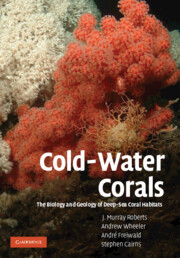2 - Cold-water corals
Published online by Cambridge University Press: 23 December 2009
Summary
It is temperature rather than depth that controls the bathymetric distribution of all corals except the shallow-water forms …
Ecology of modern marine organisms with reference to paleogeography Thomas Wayland Vaughan (1940)What is a coral? Dictionary definitions vary, probably because the concept of the word coral is not a scientific one, but rather a layman's term. Like the omnibus words ‘bug’ and ‘worm’, these words mean different things to different people and professions. In all three cases, these words refer to a polyphyletic assemblage of organisms, not a natural unit of evolution. Nonetheless, over the last century the term coral has come to refer to seven cnidarian taxa that have been defined by Cairns (2007, p. 312) as: ‘Animals in the cnidarian classes Anthozoa and Hydrozoa that produce either calcium carbonate (aragonitic or calcitic) secretions resulting in a continuous skeleton or as numerous microscopic, individualised sclerites, or that have a black, horn-like, proteinaceous axis.’ This is admittedly a cumbersome definition, but is necessarily so in order to include the seven disparate coral taxa, which are listed inTable 2.1. This classification table also gives some common names used for all or part of these seven taxa, as well as the current number of valid Recent species. From this table we see that as of early 2007, there were approximately 5160 species of corals, 65% of which occur in water deeper than 50 m.
- Type
- Chapter
- Information
- Cold-Water CoralsThe Biology and Geology of Deep-Sea Coral Habitats, pp. 20 - 66Publisher: Cambridge University PressPrint publication year: 2009
- 4
- Cited by



